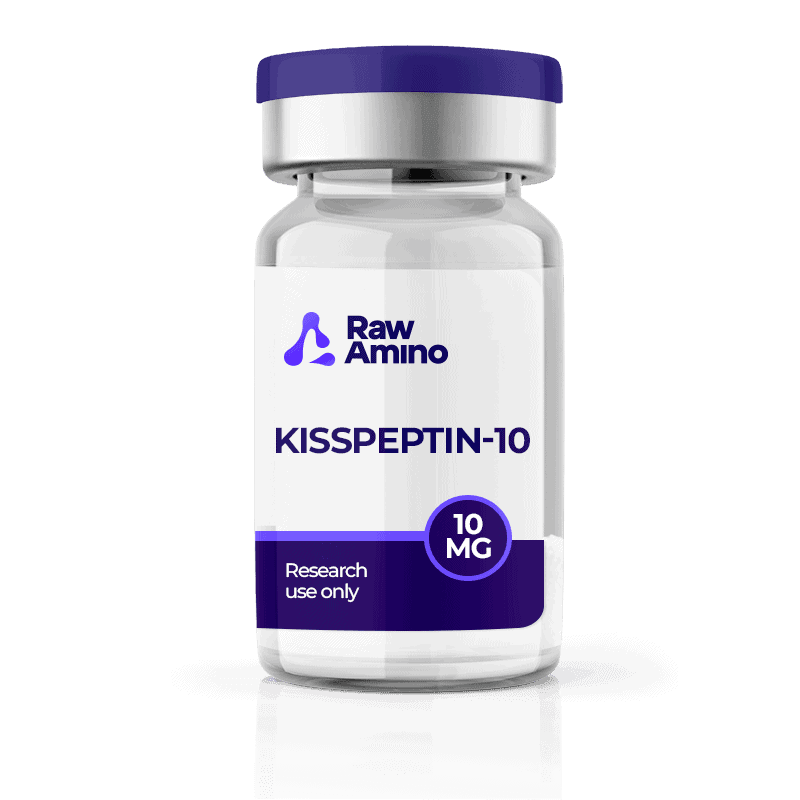
Kisspeptin-10 – 10MG
$120.00
Discount per Quantity
| Quantity | Discount | Price |
|---|---|---|
| 5 - 8 | 5% | $114.00 |
| 9 + | 10% | $108.00 |
Scientific Overview of Kisspeptin-10
Kisspeptin-10 is a short peptide fragment derived from the larger Kisspeptin family, also known as Metastin. This fragment has drawn attention for its potential role in cellular communication and regulation of signaling pathways.
Alternative Names: KISS-1, Protein KISS-1, Metastin, Kp-10 peptide
Kisspeptin-10 Studies and Research Data
Endocrine Signaling and Reproductive Pathways
Research suggests that Kisspeptin-10 may play a role in signaling within the hypothalamic-pituitary axis. Observations indicate that it can influence the release of gonadotropin-releasing hormone (GnRH), which in turn may impact luteinizing hormone and follicle-stimulating hormone production. Some studies note that Kisspeptin-10 interacts with GPR54 (KISS1) receptors, where it appears capable of modulating intracellular pathways such as calcium signaling and kinase activation. Findings also suggest that repeated exposure might contribute to receptor desensitization, potentially altering hormone regulation over time.
Kisspeptin-10Interactions with Energy and Metabolism
Experimental studies imply that Kisspeptin-10 may be involved in pathways connecting metabolic processes with reproductive signaling. In laboratory models, it has been associated with the regulation of hypothalamic neurotransmitters and genes such as neuropeptide Y (NPY) and brain-derived neurotrophic factor (BDNF). These observations suggest potential links between Kisspeptin-10, appetite regulation, and neuronal activity related to energy homeostasis.
Cellular Proliferation and Migration
Kisspeptin-10 has been studied for its possible role in cellular proliferation and movement, particularly within experimental cancer models. Evidence suggests that reduced expression of endogenous kisspeptins in certain tissues may correspond with more favorable environments for cellular spread. Conversely, experimental introduction of Kisspeptin-10 has been associated with changes in migration and adhesion dynamics of malignant cells, pointing to potential regulatory influences in tumor-related signaling.
Kisspeptin-10 and Neurobiological Findings
Laboratory research indicates that Kisspeptin-10 might interact with neural pathways beyond its endocrine role. Data suggest it could influence brain regions involved in behavioral responses, including motivation and reward-related processing. Additionally, preliminary evidence points to Kisspeptin-10’s potential to counteract cellular stress linked with α-synuclein in experimental neuronal systems. Computational modeling suggests possible direct interactions between Kisspeptin-10 and α-synuclein, which may reduce protein aggregation.
Vascular and Renal Considerations
Studies propose that Kisspeptin-10 and its receptors are present in renal tissues, where they may contribute to kidney development and vascular regulation. Laboratory observations have suggested that altered kisspeptin signaling may influence kidney tissue organization in models of chronic impairment. Furthermore, some experimental evidence suggests that Kisspeptin-10 may contribute to vasoconstriction and changes in cardiac output under specific conditions, although the precise mechanisms remain under investigation.
Conclusion
Kisspeptin-10 is being explored as a peptide with potential roles in reproductive regulation, metabolic processes, neuronal function, and cellular migration. Current findings suggest diverse pathways of interest, though outcomes vary across studies. Continued research is necessary to clarify its broader biological significance.
References
- George JT, Veldhuis JD, Roseweir AK, Newton CL, Faccenda E, Millar RP, Anderson RA. Kisspeptin-10 is a potent stimulator of LH and increases pulse frequency in men. J Clin Endocrinol Metab. 2011 Aug;96(8):E1228-36. doi: 10.1210/jc.2011-0089. Epub 2011 Jun 1. PMID: 21632807; PMCID: PMC3380939.
- Navarro VM. Metabolic regulation of kisspeptin – the link between energy balance and reproduction. Nat Rev Endocrinol. 2020 Aug;16(8):407-420. doi: 10.1038/s41574-020-0363-7. Epub 2020 May 19. PMID: 32427949; PMCID: PMC8852368.
- Shoji I, Hirose T, Mori N, Hiraishi K, Kato I, Shibasaki A, Yamamoto H, Ohba K, Kaneko K, Morimoto R, Satoh F, Kohzuki M, Totsune K, Takahashi K. Expression of kisspeptins and kisspeptin receptor in the kidney of chronic renal failure rats. Peptides. 2010 Oct;31(10):1920-5. doi: 10.1016/j.peptides.2010.07.001. Epub 2010 Jul 17. PMID: 20621140.
- Pazarci P, Kaplan H, Alptekin D, Yilmaz M, Lüleyap U, Singirik E, Pelit A, Kasap H, Yegani A. The effects of daylight exposure on melatonin levels, Kiss1 expression, and melanoma formation in mice. Croat Med J. 2020 Feb 29;61(1):55-61. doi: 10.3325/cmj.2020.61.55. PMID: 32118379; PMCID: PMC7063558.
- Simon, C., Soga, T., & Parhar, I. (2023). Kisspeptin-10 Mitigates α-Synuclein-Mediated Mitochondrial Apoptosis in SH-SY5Y-Derived Neurons via a Kisspeptin Receptor-Independent Manner. International journal of molecular sciences, 24(7), 6056. https://doi.org/10.3390/ijms24076056
- Comninos AN, Wall MB, Demetriou L, Shah AJ, Clarke SA, Narayanaswamy S, Nesbitt A, Izzi-Engbeaya C, Prague JK, Abbara A, Ratnasabapathy R, Salem V, Nijher GM, Jayasena CN, Tanner M, Bassett P, Mehta A, Rabiner EA, Hönigsperger C, Silva MR, Brandtzaeg OK, Lundanes E, Wilson SR, Brown RC, Thomas SA, Bloom SR, Dhillo WS. Kisspeptin modulates sexual and emotional brain processing in humans. J Clin Invest. 2017 Feb 1;127(2):709-719. doi: 10.1172/JCI89519. Epub 2017 Jan 23. PMID: 28112678; PMCID: PMC5272173.
- Rønnekleiv OK, Kelly MJ. Kisspeptin excitation of GnRH neurons. Adv Exp Med Biol. 2013;784:113-31. doi: 10.1007/978-1-4614-6199-9_6. PMID: 23550004; PMCID: PMC4019505.
- Sato K, Shirai R, Hontani M, Shinooka R, Hasegawa A, Kichise T, Yamashita T, Yoshizawa H, Watanabe R, Matsuyama TA, Ishibashi-Ueda H, Koba S, Kobayashi Y, Hirano T, Watanabe T. Potent Vasoconstrictor Kisspeptin-10 Induces Atherosclerotic Plaque Progression and Instability: Reversal by its Receptor GPR54 Antagonist. J Am Heart Assoc. 2017 Apr 14;6(4):e005790. doi: 10.1161/JAHA.117.005790. PMID: 28411243; PMCID: PMC5533042.
- Jayasena CN, Nijher GM, Abbara A, Murphy KG, Lim A, Patel D, Mehta A, Todd C, Donaldson M, Trew GH, Ghatei MA, Bloom SR, Dhillo WS. Twice-weekly administration of kisspeptin-54 for 8 weeks stimulates release of reproductive hormones in women with hypothalamic amenorrhea. Clin Pharmacol Ther. 2010 Dec;88(6):840-7. doi: 10.1038/clpt.2010.204. Epub 2010 Oct 27. PMID: 20980998.
- Orlando G, Leone S, Ferrante C, Chiavaroli A, Mollica A, Stefanucci A, Macedonio G, Dimmito MP, Leporini L, Menghini L, Brunetti L, Recinella L. Effects of Kisspeptin-10 on Hypothalamic Neuropeptides and Neurotransmitters Involved in Appetite Control. Molecules. 2018 Nov 24;23(12):3071. doi: 10.3390/molecules23123071. PMID: 30477219.
- Jayasena CN, Nijher GM, Comninos AN, Abbara A, Januszewki A, Vaal ML, Sriskandarajah L, Murphy KG, Farzad Z, Ghatei MA, Bloom SR, Dhillo WS. The effects of kisspeptin-10 on reproductive hormone release show sexual dimorphism in humans. J Clin Endocrinol Metab. 2011 Dec;96(12):E1963-72. doi: 10.1210/jc.2011-1408. Epub 2011 Oct 5. PMID: 21976724.
Disclaimer:
The products mentioned are intended solely for laboratory research and in-vitro experimentation. They are not approved for human or animal use of any kind. All details provided are for educational purposes only. By purchasing from this site, you agree to comply with our Terms and Conditions.
Only logged in customers may leave a review.
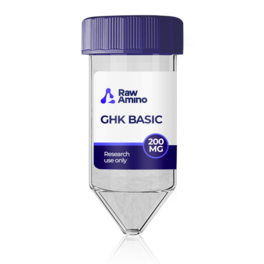
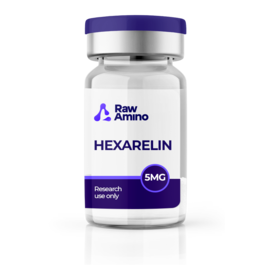
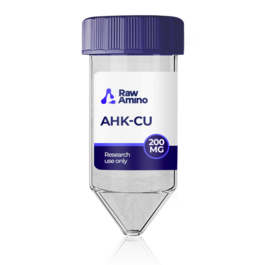
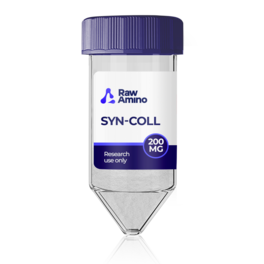
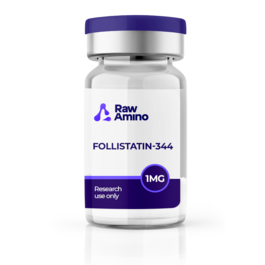
Reviews
There are no reviews yet.